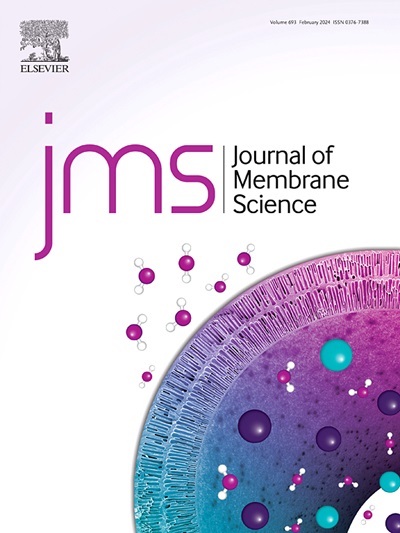具有可调孔结构的无机纳米片工程陶瓷膜,用于单分散和稳定的乳液
IF 8.4
1区 工程技术
Q1 ENGINEERING, CHEMICAL
引用次数: 0
摘要
多孔陶瓷膜在乳液制备中的应用越来越受到人们的关注。然而,相邻孔隙之间的距离有限且难以控制,往往导致液滴聚并,导致乳状液尺寸大、分布广、稳定性差。在这里,利用二维Ti3C2Tx和TiO2溶胶作为平台,我们提出了一种新颖的、可扩展的策略来设计具有扩大和可调孔径的陶瓷膜,特别针对乳化进行了优化。通过在TiO2溶胶颗粒中铺设Ti3C2Tx纳米片形成分区,破坏了TiO2颗粒的均匀堆积,从而增加了孔隙间距,减少了乳液聚集。通过调节Ti3C2Tx纳米片的尺寸,可以精确地调节邻近的孔距(0.5-2.2 μm),从而实现比TiO2粒径大7倍的孔距,超越传统的陶瓷膜。因此,使用工程TiO2-Ti3C2Tx膜和双表面活性剂体系(Span 85/Tween 80),我们成功制备了尺寸可调(平均粒径:1.44-2.59 μm)、单分散(Span: 0.73-1.2)生物重油水乳液,具有优异的稳定性(长达2个月),与之前报道的体系相比,在液滴尺寸和均匀性方面有了显著改善。该方法为制备具有易于调节孔隙结构的乳化功能陶瓷膜提供了一种有效且可扩展的方法,促进了用于各种乳化应用的高性能膜材料的发展。本文章由计算机程序翻译,如有差异,请以英文原文为准。

Inorganic nanosheet-engineered ceramic membranes with tunable pore structures for monodisperse and stable emulsions
Porous ceramic membranes have gained increasing attention for emulsion preparation. However, the limited and challenging-to-control distances between adjacent pores often lead to droplet coalescence, resulting in emulsions with large sizes, wide distributions, and poor stability. Here, leveraging 2D Ti3C2Tx and TiO2 sol as platforms, we present a novel and scalable strategy for designing ceramic membranes with enlarged and tunable pore distances, specifically optimized for emulsification. By laying Ti3C2Tx nanosheets into TiO2 sol particles to form partitions, the uniform stacking of TiO2 particles is disrupted, thereby increasing the pore spacing and minimizing emulsion aggregation. The adjacent pore distances (0.5–2.2 μm) can be precisely tuned by regulating the Ti3C2Tx nanosheet dimensions, achieving pore distances up to seven times larger than the TiO2 particle size, surpassing conventional ceramic membranes. Consequently, using the engineered TiO2–Ti3C2Tx membranes and a dual-surfactant system (Span 85/Tween 80), we successfully prepared size-tunable (average particle size: 1.44–2.59 μm), monodisperse (span: 0.73–1.2) water-in-bio-heavy oil emulsions with exceptional stability (up to 2 months), showing substantial improvements in droplet size and uniformity compared to previously reported systems. This approach offers an effective and scalable method for fabricating emulsification-functional ceramic membranes with easily adjustable pore structures, advancing the development of high-performance membrane materials for a variety of emulsification applications.
求助全文
通过发布文献求助,成功后即可免费获取论文全文。
去求助
来源期刊

Journal of Membrane Science
工程技术-高分子科学
CiteScore
17.10
自引率
17.90%
发文量
1031
审稿时长
2.5 months
期刊介绍:
The Journal of Membrane Science is a publication that focuses on membrane systems and is aimed at academic and industrial chemists, chemical engineers, materials scientists, and membranologists. It publishes original research and reviews on various aspects of membrane transport, membrane formation/structure, fouling, module/process design, and processes/applications. The journal primarily focuses on the structure, function, and performance of non-biological membranes but also includes papers that relate to biological membranes. The Journal of Membrane Science publishes Full Text Papers, State-of-the-Art Reviews, Letters to the Editor, and Perspectives.
 求助内容:
求助内容: 应助结果提醒方式:
应助结果提醒方式:


